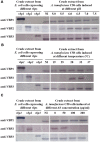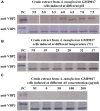Expression of Agrobacterium Homolog Genes Encoding T-complex Recruiting Protein under Virulence Induction Conditions
- PMID: 26696988
- PMCID: PMC4667095
- DOI: 10.3389/fmicb.2015.01379
Expression of Agrobacterium Homolog Genes Encoding T-complex Recruiting Protein under Virulence Induction Conditions
Abstract
The proteins encoded by three Agrobacterial genes, atu5117, atu4860, and atu4856, are highly homologous to each other in amino acid sequence. All three proteins can bind to VirD2 and are named VBP1, VBP2, and VBP3 (VirD2-binding protein), respectively. VBP is involved in T-DNA transfer by recruiting the T-complex from the cytosol to the polar transport apparatus T4SS (type IV secretion system) and is defined as the "T-complex recruiting protein." However, it remains unknown how these three homologous genes co-exist in a relatively small prokaryotic genome. To understand whether these three homologous genes are expressed differentially under virulence induction conditions, we examined the effects of virulence induction conditions, including various pH values, temperatures and acetosyringone (AS, an effective virulence inducer to Agrobacterium tumefaciens) concentrations, on the expression of the three VBP-encoding genes. Our data showed that vbp1 (atu5117) and vbp3 (atu4856) maintained constant expression under the tested induction conditions, whereas the expression of vbp2 (atu4860) was affected by the conditions. Culture conditions favorable to the expression of vbp2 differed from the reported induction conditions for other virulence proteins. In particular, the pH value was a crucial factor for the expression of vbp2. In addition, the deletion of vbp1 affected the expression of vbp2. Taken together, these results suggest that the mechanisms regulating the expression of these three homologous genes are different from the virulence induction mechanism and that VBP homologs are presumably involved in other biological processes in addition to T-complex recruitment.
Keywords: Agrobacterium; T-complex recruiting protein; gene expression; virD2-binding protein (VBP); virulence induction.
Figures





Similar articles
-
Agrobacterium VirD2-binding protein is involved in tumorigenesis and redundantly encoded in conjugative transfer gene clusters.Mol Plant Microbe Interact. 2007 Oct;20(10):1201-12. doi: 10.1094/MPMI-20-10-1201. Mol Plant Microbe Interact. 2007. PMID: 17918622
-
Dimerization of VirD2 binding protein is essential for Agrobacterium induced tumor formation in plants.PLoS Pathog. 2014 Mar 13;10(3):e1003948. doi: 10.1371/journal.ppat.1003948. eCollection 2014 Mar. PLoS Pathog. 2014. PMID: 24626239 Free PMC article.
-
Identification and characterization of the biochemical function of Agrobacterium T-complex-recruiting protein Atu5117.FEBS J. 2013 Oct;280(19):4865-75. doi: 10.1111/febs.12460. Epub 2013 Aug 23. FEBS J. 2013. PMID: 23902381
-
Role of the Agrobacterium tumefaciens VirD2 protein in T-DNA transfer and integration.Mol Plant Microbe Interact. 1998 Jul;11(7):668-83. doi: 10.1094/MPMI.1998.11.7.668. Mol Plant Microbe Interact. 1998. PMID: 9650299
-
Is there any crosstalk between the chemotaxis and virulence induction signaling in Agrobacterium tumefaciens?Biotechnol Adv. 2017 Jul;35(4):505-511. doi: 10.1016/j.biotechadv.2017.03.008. Epub 2017 Mar 23. Biotechnol Adv. 2017. PMID: 28342941 Review.
Cited by
-
Agrobacterium tumefaciens ferritins play an important role in full virulence through regulating iron homeostasis and oxidative stress survival.Mol Plant Pathol. 2020 Sep;21(9):1167-1178. doi: 10.1111/mpp.12969. Epub 2020 Jul 17. Mol Plant Pathol. 2020. PMID: 32678502 Free PMC article.
-
The Divergent Key Residues of Two Agrobacterium fabrum (tumefaciens) CheY Paralogs Play a Key Role in Distinguishing Their Functions.Microorganisms. 2021 May 24;9(6):1134. doi: 10.3390/microorganisms9061134. Microorganisms. 2021. PMID: 34074050 Free PMC article.
References
-
- Baron C., Domke N., Beinhofer M., Hapfelmeier S. (2001). Elevated temperature differentially affects virulence, VirB protein accumulation, and T-pilus formation in different Agrobacterium tumefaciens and Agrobacterium vitis strains. J. Bacteriol. 183 6852–6861. 10.1128/JB.183.23.6852-6861.2001 - DOI - PMC - PubMed
LinkOut - more resources
Full Text Sources
Other Literature Sources
Research Materials

